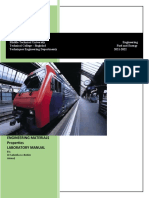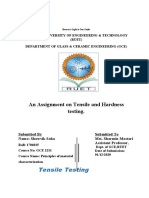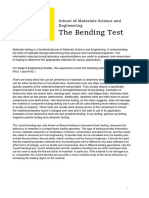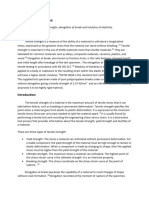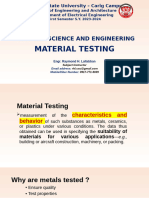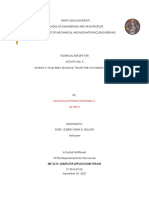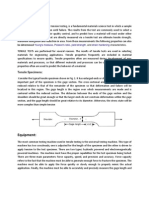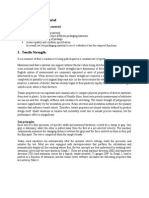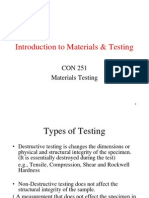The Process of Maintenance
Uploaded by
Usman MalikThe Process of Maintenance
Uploaded by
Usman MalikJournal of
Materials Sciences and Applications
Casereport Open Access
The Process of Maintenance and Assessment of The Universal Testing Material
Machine H50KS
Ayman Abu Ghazal*
Jordan Atomic Energy Commission, Amman, Jordan
*Corresponding author: Ayman Abu Ghazal, Jordan Atomic Energy Commission, Amman, Jordan, Tel: 00962791802192,
Email: gazal.ayman@yandex.ru
Received Date: September 21, 2020 Accepted Date: October 23, 2020 Published Date: October 26, 2020
Citation: Ayman Abu Ghazal (2020) The Process of Maintenance and Assessment of The Universal Testing Material Machine
H50KS. J Mater sci Appl 4: 1-12.
Abstract
The main goal of this report is to show the steps of maintenance and testing of the universal material testing ma-
chine - H50KS, present in the material testing laboratory in Research Laboratories and Information Directorate - Jordan
Atomic Energy Commission. Starting from the stage of collecting primary information about the device, then identifying
technical problems, finishing with the initiation of the device, which includes getting successful results when conducting a set
of experiments that include testing several samples of High-density polyethylene (HDPE). The universal testing machine is
mainly used to study the mechanical properties of materials; based on the obtained results we can judge whether the material
is suitable for industrial utility, or needs further improvements to its properties. The material testing machine is considered as
one of the most essential devices that shape the core of any materials testing laboratory worldwide. Given the limited budget
available, an approach with the minimum cost was necessary.
Keywords: Universal material testing machine; tensile testing; polymers; High-density polyethylene.
©2020 The Authors. Published by the JScholar under the terms of the Crea-
tive Commons Attribution License http://creativecommons.org/licenses/
by/3.0/, which permits unrestricted use, provided the original author and
source are credited.
JScholar Publishers J Mater sci Appl 2020 | Vol 4: 204
2
Glossary of terms [2]: Introduction
Tensile testing: A method of determining the behavior of ma- A tensile testing machine is a special testing device de-
terials subjected to uniaxial loading, which tends to stretch the signed for the purpose of performing static tests and determin-
material which is a metal. A longitudinal specimen of known ing the mechanical properties of materials under axial tension,
length and diameter is gripped on both ends and stretched at a compression, and bending within the technical capabilities of the
slow, controlled rate until rupture occurs. Also known as tension machine. Structurally, the machine consists of a loading device
testing. (either hydraulic or mechanical) and measuring parts, that re-
cord the changes in the applied force and deformation on the
Specimen: The object being tested is often of standard dimen-
tested sample (Figure1).
sions or configuration, used for destructive or nondestructive
testing. One or more specimens may be taken from each sample.
Strain: The amount of change in the size or shape of a body due
to the applied force. Also known as nominal strain.
Tensile strength: The ratio of maximum load to the origi-
nal cross-sectional area of material during tensile testing. Also
known as ultimate strength.
Ductility: The ability of a material to deform plastically before
fracturing.
Extensometer: An instrument used for measuring changes in
length for a given gage length caused by application or removal
of a force.
Gage length: The length of the portion of a specimen for which
strain, change in length, or other characteristics are determined.
Figure 1: The main parts of the material testing machine.
Elongation, percent: The extension of the uniform section of a Testing machines can be used at metallurgical plants,
specimen expressed as a percentage of the original gage length: where constant quality control of the produced rolled metal is
required; Similarly, in the nuclear industry, we are concerned
with measuring the mechanical properties of the irradiated fuel
where L0 is the original gage length, and Lx is the final gage length. element sheath and crack growth monitoring [1].
Brittle fracture: The Breakage of a solid accompanied by little Tensile test results are useful in the selection of mate-
or no macroscopic plastic deformation. Typically, brittle fracture rials for engineering applications. For quality assurance, tensile
occurs by rapid crack propagation with less expenditure of ener- strength characteristics are often included in material specifica-
gy compared to ductile fracture. tions. Tensile properties are often measured during the produc-
tion of new materials and the development of new process-
Grips: Part of the specimen used for holding it between the fixed es so that different materials and processes can be compared.
and movable members of the testing machine; can be either of Finally, tensile properties are often used to predict the behavior
the fixed or self-aligning type [3]. of a material under load types other than uniaxial tension. The
strength of the material is often the main concern.
Yield point: The first point on a stress-strain curve at which an
increase in strain occurs without an increase in stress. The strength of interest can be expressed either in terms
of the stress required to cause noticeable plastic deformation or
Tensile stress-strain curve: A diagram on which values of ten-
in terms of the maximum stress that the material can withstand.
sile stress are plotted as ordinates against corresponding values
These strength measures are used precisely in engineering de-
of tensile strain as abscissas.
signs. Another parameter of interest is the plasticity of a material,
JScholar Publishers J Mater sci Appl 2020 | Vol 4: 204
3
which is a measure of how much it can be deformed before it General tensile test procedure according to ASTM D638
splits. – 14 (Standard Test Method for Tensile Properties of
Plastics)
Ductility is rarely included directly in the design; rather,
it is included in the material’s specifications to ensure quality and
1. Measure the width and thickness of each specimen to
strength. Low ductility in tensile testing is often accompanied by
the nearest 0.025 mm:
low fracture resistance in other types of loading. Elastic proper-
• Measure the width and thickness of the flat section at
ties may also be of interest, but special methods must be used to
the center of each specimen and within 5 mm of each end of the
measure these properties during tensile tests, and more accurate
gage length.
measurements can be made using ultrasonic methods [2].
• For the injection of molded specimens, the actual meas-
Tensile testing machines are also known as universal urements of only one specimen from each sample will suffice
testing machines. These machines hold specimens to be tested when it has been previously demonstrated that the specimen-to-
using grips that tightly hold each end. One grip keeps the mate- specimen variation in width and thickness is less than 1 %.
rial in place, while the other grip pulls until the tensile specimen • Measure the diameter of rod specimens, in addition to
ultimately break. Consider the typical tensile specimen shown the inside and outside diameters of tube specimens, to the near-
in Figure 2. It has enlarged ends or shoulders for gripping as de- est 0.025 mm.
scribed earlier. 2. Place the specimen in the grips of the testing machine,
with the careful alignment of the long axis of the specimen and
During the test, the specimen will slowly elongate at the grips with an imaginary line joining the points of attachment
a standardized speed. The data collection software will record of the grips to the machine. Tighten the grips evenly and firmly
the material’s test parameters, as well as the changes in the gage to the degree necessary to prevent slippage of the specimen dur-
length. The software monitors the force being applied upon the ing the test, but not to the point where the specimen would be
specimen and display the stress-strain curve, which helps in the crushed.
analysis of the specimen’s behavior throughout the test.
Figure 2: Typical tensile test specimen, showing a reduced gage section and enlarged shoulders
JScholar Publishers J Mater sci Appl 2020 | Vol 4: 204
4
3. Attach the extension indicator. for determining the distance between two designated points
4. Set the speed of testing to the proper rate, and start the within the gauge length of the test specimen as the specimen is
machine. stretched. Extensometer is used to measure the exact changes in
5. Record the load-extension curve of the specimen. the length of the tested sample [3]. This error appeared when
6. Record the load and extension at the yield point (if any the cable was connected between the extensometer and the port
exists) in addition to the load and extension at the moment of device screen. Note that the machine works normally when the
rupture. cable of the extensometer is disconnected & the error disappears
on the screen as shown in Figure 4.
Technical problems of the machine
As mentioned earlier, this report is concerned with the
stages of the rehabilitation of the material inspection device for
the purpose of returning it into service and to verify the accuracy
of the results after the repair process. The device was made in the
United Kingdom by Hounsfield Company, and its specifications
are shown in Table 1:
Manufacturer Hounsfield U.K
Model H50KS
Serial № TX0187
Max .capacity 50 kilo Newton
Extensometer 100 R/S Figure 4: Shows how the error message disappears when discon-
necting the cable.
Table 1: UTM machine characteristic
Therefore, we conclude that the tensile testing machine
After checking the machine, the following problems were found:
H50KS is not able to perform any of the mechanical applications
intended for it.
1. The software of the tensile testing machine is missing
due to the fact that the hard disk of the attached computer is
Progression through problem solving
damaged.
2. When turning on the machine, whether manually or
A series of steps were followed to solve problems in-
automatically, and during the test, the machine suddenly stops
cluding collecting data, problem analysis, finding applicable
working.
solutions, testing, and stating conclusions.
3. When connecting the Extensometer to the machine, an
It was found that the Hounsfield Company was acquired
error message appears on the LCD screen of the machine (see
by Tinius Olsen Company about 15 years ago. And by commu-
Figure 3).
nicating with the sales department of the company Tinius Olsen
NOTE: Extension Indicator (extensometer): An instrument used
located in London, the device’s software was requested for free.
Figure 3: As seen, the tensile testing machine shows an error message (Err. L/C), indicated by the arrow
JScholar Publishers J Mater sci Appl 2020 | Vol 4: 204
5
However, the response was that this software was no longer effec- Problem № (3) was clarified through communication
tive for a long time. with the Technical Support Department of Tinius Olsen compa-
ny and it was concluded that there are two possibilities: failure of
After disassembling and checking the machine, it was the cable connecting the extensometer to the machine, or dam-
clear that the main cause of problem № (2) was the failure of the age to one of the parts of the Signal conditional interface card.
emergency button, moreover, bending in one of the control rods
was found, which led to the application of excess load on the The company’s technical support department sent a
electronic parts within the machine. Finally, the damaged parts copy of the electronic chart (see Figure 6) for use during the ex-
were replaced with new ones, costing10 $. See Figure 5. amination and identification of the damaged electronic parts.
After examining the cable, it was found that it is work-
ing well without any problems. Given that, the chance that one of
the Signal conditional interface card parts is damaged becomes
high. After testing, it was certainly found that both of the elec-
trical fuses F1 and F2 (Fuse F LBC Quick Acting Mini 1 Amp
20mm×5mm) were damaged. The required parts were purchased
for 5 $. After being installed and reconnecting the extensometer
to the machine, the error message (Err. L/C) disappeared, and
readings appeared on the LCD screen.
The device was equipped with a laser printer, after being
rehabilitated and repaired, to obtain printed results and depend-
ing on the LCD screen to show the results after performing the
Figure 5: In order to avoid any financial expenses, Eng. Diaa
tests. Finally, it can be said that problem number one has been
Ghassan (from the private sector) volunteered to solve the tech-
solved.
nical problems
Figure 6: The electronic chart of the Signal conditional interface card, shows the damage electrical fuses F1 and F2
JScholar Publishers J Mater sci Appl 2020 | Vol 4: 204
6
Outputs and Deliverables lack of other types of cutting dies was the only reason behind the
reduced use of the second type of samples.
The samples were prepared using an Automatic Hy-
draulic Press Machine, where a sheet of high-density polyeth- The results from the tensile test for both Sample №1 and
ylene, Figure 7, was prepared from ore available in the labora- Sample №2 are shown in Figure (10). We can notice from Figure
tory. The ore form was exposed to a force of 30,000 pounds and (10) that the strength corresponding to the Yield point is approx-
heated to a temperature of 300 degrees Fahrenheit. imately 600 Newton, which is equivalent to 28 MPa for Sample
№1 and Sample №2 respectively.
Using Specimen Preparation Punching Machine, a
batch of samples was cut following ASTM D638, Figure 9. The
Figure 8: The geometric dimensions of type II sample according to ASTM D638
Figure 9: The preparation process of HDPE samples in the Materials Testing Laboratory
Figure 10: Tensile test results for HDPE samples (1 & 2) prepared in the Materials Testing Laboratory
JScholar Publishers J Mater sci Appl 2020 | Vol 4: 204
7
The difference is clear in the values of Elongation at In literature [4] and [6], It can be seen that results from
breakage, Sample №1 elongation ratio is approximately 100%, the tensile test for HDPE samples, containing defects of different
however, Sample № 2 elongation ratio reached approximately lengths, which led to a decrease in ductility (Less ductile), affect-
35%. The behavior of the two curves is approximately the same, ing the nature of the fracture and making it less elastic, see Figure
however, it does not correspond to the normal curve behavior 12.
that appears normally for such types of tests, see Figure 11, [4].
Comparing the obtained tensile test results from both
As it is known, there are several factors affecting the Elongation Samples №1 & №2, we can see that they behave similarly and
at breakage values [5]: match the results from samples of HDPE material containing dif-
• Speed of Testing: Slow testing allows for polymer relax- ferent cracks.
ation and higher elongation at break values
• Orientation Level: Fibers that are less oriented tend to We Conclude that the preparation process of the poly-
exhibit greater degrees of elongation at breakage. mer sheet in the laboratory was not done properly, which led to
• Temperature: In general, elongation at breakage in- heterogeneity in the final sheet from which samples 1&2 were
creases with an increase in temperature cut, due to the formation of internal defects ( gas bubbles), see
• Filler Content: The elongation at breakage of compos- Figure (13), which in turn, affected many factors during the test,
ites decreases with an increase in the filler content of which caused the samples not to undergo enough elongation,
achieved by pure HDPE samples shown in Figure (11).
Several potential problems must be pointed out during
the test set-up, including specimen misalignment and worn A new sheet was re-prepared correctly by consulting
grips. The physical alignment for the two points of attachment the chemical engineer Sewar Aljarrah from the Jordan Univer-
for the specimen is essential because any off-center loading will sity of Science and Technology to get the optimum preparation
exert a bending load on the specimen. This is critical in the test- method to avoid any of the mistakes in the previous experiment.
ing of brittle materials and may cause problems even for ductile
materials. The alignment will be affected by the testing-machine Figure 14 shows the new tensile test results for HDPE
load frame, any grips and fixtures used, in addition to the spec- Samples 3&4, we can see clearly that the Strength at Yield is ap-
imen itself. Misalignment may also induce load-measurement proximately 580 Newton, which is equivalent to 27 MPA for both
errors due to the passage of bending forces through the load- samples 3&4, The Elongation as a percentage is approximately
measuring apparatus [2]. 328% and 240 % for samples 3 and 4, respectively. The curve
behavior for both samples is very similar, considered valid, and
corresponds to the normal curve behavior of the tensile test in
such type of testing, see Figure 11.
Table (2) presents a summary of the tensile test results
for a group of HDPE samples prepared and tested in the labora-
tory using the Tensile testing machine H50KS, where the main
focus was on presenting the values of Elongation at breakage &
Stress at a yield.
Figure 15 shows the result of the tensile test sample №
12, as shown from the curve, we note that the sample reached
enough elongation (796%) and how clearly the curve behavior
satisfied the normal curve of HDPE polyethylene, Figure (11).
Figure 11: The typical Stress-strain curve of pure HDPE.
JScholar Publishers J Mater sci Appl 2020 | Vol 4: 204
8
Figure 12 (a): Stress-Strain Curve for HDPE samples with 1mm cracks (b): Stress-Strain curve for pure HDPE sample contain-
ing a single crack.
Figure 13: Images taken by a micro-camera showing the gas bubbles in the rupture area after the end of the tensile test for sam-
ples 1&2, prepared in the Material Testing Laboratory.
Figure 14: Tensile test results for HDPE samples 3 & 4, prepared in the Materials Testing Laboratory
J Mater sci Appl 2020 | Vol 4: 204
9
Tensile Reference
Mechanical №1 №2 №3 №4 №5 №6 №7 №8 №9 №10 №11 №12 Values[7] Min
– Max
Properties
Elongation
100 35 328 240 380 100 735 47 90 751 800 796 3.00 - 1900
at breakage
(%)
Stress at
yield 28.0 28.0 27.0 27.0 19.0 28.0 17.0 27.0 21.0 20.0 27.0 52 2.69 - 200
(MPa)
Table 2: Tensile mechanical properties for a group of HDPE samples
Figure 15: Tensile Successful test for HDPE sample № 12, prepared and tested in the Materials Laboratory by tensile testing
machine H50KS.
JScholar Publishers J Mater sci Appl 2020 | Vol 4: 204
10
Conclusions 6. Making the Tensile Testing machine, located in the
Materials Testing Laboratory, available for scientific research by
1. All three technical problems concerning the material students or researchers in general, thus making it available for
testing machine H50KS were successfully solved using mini- commercial use.
mum financial costs, given the limited capabilities, following the
experimental Scientific methodology based on research, consul- Acknowledgement
tation, and volunteer work.
Special thanks to Eng. Sara A.Rahim AlKhdour from
2. Samples (№5-№12) in table 2 were tested under the the Nuclear Engineering Department from Jordan University of
same conditions as samples 1,2, 3 & 4.We can notice that for Science and Technology for proofreading and editing the report
some samples , elongation reached 1000% while others did not to ensure it is grammatically correct.
exceed 50%, depending on the factors mentioned previously.
3. Results for all HDPE samples prepared in the materi-
al testing laboratory and tested, using the tensile test machine
H50KS after maintenance, satisfied with acceptable range values
published in the international database [7].
Next steps
1. The Main accomplishment throughout the maintenance
process done, is that the Tensile Testing Machine (H50KS) went
through a process of maintenance with very limited resources
and negligible cost, resulting in a machine used in testing sam-
ples giving acceptable results, all from scratch.
2. Testing the repaired Tensile Testing Machine (H50KS)
using various reference samples including samples of Stainless
steel, Carbon steel, Aluminum, Copper, and Lead. The purpose
behind this is to test the machine’s performance on different met-
al samples.
3. Development and redesign of the machine’s grips were
used to handle the sample from both sides during the test. The
goal of such modification is to make the machine capable of han-
dling samples of different shapes, such as cylindrical samples.
4. Development of a new system, including both hardware
and software, used for the monitoring of polymer samples (such
as Polyethylene) during the process of Tensile testing.
5. Exhibition of a future plan to follow according to the in-
ternational standards developed for the acquirement of the ISO
certification from the International Organization for Standard-
ization, if acceptable results continue to be collected using the
machine from different samples.
JScholar Publishers J Mater sci Appl 2020 | Vol 4: 204
11
References
1) International Atomic Energy Agency. (2007). Charac-
terization and testing of materials for nuclear reactors: Proceed-
ings of a technical meeting held in Vienna, May 29--June 2, 2006.
2) Davis, J. R. (2004). Tensile testing (2nd ed.). ASM Inter-
national.
3) D638 – 14. Standard Test Method for Tensile Properties
of Plastics. 10.1520/D0638-14. Page 3.
4) El-Sheikhy, Refat, & Al-Shamrani, Mosleh. (2015). On
the Processing and Properties of Clay/Polymer Nanocomposites
CPNC. Latin American Journal of Solids and Structures, 12(2),
385-419. https://dx.doi.org/10.1590/1679-78251399.
5) Elongation at break or fracture strain: Technical prop-
erties of plastics. (n.d.). Plastic Materials | Free Online Database
for Plastic Industry. https://omnexus.specialchem.com/polymer-
properties/properties/elongation-at-break
6) Shaofeng Li, Kang Qi. The Mechanical and Fracture
Property of HDPE-Experiment Result Combined with Simu-
lation. Master’s Degree Thesis ,ISRN: BTH-AMT-EX-a-2014/
D07—SE, Blekinge Institute of Technology Karlskrona, Sweden
,2014.
7) MatWeb - The online materials information resource.
(n.d.). Retrieved from https://www.matweb.com/search/Data-
Sheet.aspx?MatGUID=482765fad3b443169ec28fb6f9606660&c
kck=1 Submit your manuscript to a JScholar journal
and benefit from:
¶¶ Convenient online submission
¶¶ Rigorous peer review
¶¶ Immediate publication on acceptance
¶¶ Open access: articles freely available online
¶¶ High visibility within the field
¶¶ Better discount for your subsequent articles
Submit your manuscript at
http://www.jscholaronline.org/submit-manuscript.php
JScholar Publishers J Mater sci Appl 2020 | Vol 4: 204
You might also like
- Design and Construct A Horizontal Tensile Testing Machine For Polymer CompositesNo ratings yetDesign and Construct A Horizontal Tensile Testing Machine For Polymer Composites49 pages
- Saddle Support Design of Horizontal Vessels As Per Asme Section Viii, Div.250% (2)Saddle Support Design of Horizontal Vessels As Per Asme Section Viii, Div.26 pages
- Exploring Tensile Testing A Comprehensive GuideNo ratings yetExploring Tensile Testing A Comprehensive Guide8 pages
- Engineering Materials Properties Laboratory Manual: BY: DR - Sabeeha A.J.Beden AhmedNo ratings yetEngineering Materials Properties Laboratory Manual: BY: DR - Sabeeha A.J.Beden Ahmed66 pages
- Material Testing, and Phase Diagram: Nada Ibrahim El Kafrawy Dr. Tarek Al-Mahdy Eng. Khaled Hamed Mechatronics-Y2 Sec 2No ratings yetMaterial Testing, and Phase Diagram: Nada Ibrahim El Kafrawy Dr. Tarek Al-Mahdy Eng. Khaled Hamed Mechatronics-Y2 Sec 26 pages
- GROUP 8 - Material Testing Written Report (MEC 0325-1)No ratings yetGROUP 8 - Material Testing Written Report (MEC 0325-1)22 pages
- Altinbas University Industrial Engineering Ie258 Manufacturing Process Lab. Tension, Bending, Compression and Torsion Test100% (1)Altinbas University Industrial Engineering Ie258 Manufacturing Process Lab. Tension, Bending, Compression and Torsion Test19 pages
- Engineering Materials Lab. No. (1) : Komar University of Science and TechnologyNo ratings yetEngineering Materials Lab. No. (1) : Komar University of Science and Technology8 pages
- 07 - Destructive and Non-Destructive TestingNo ratings yet07 - Destructive and Non-Destructive Testing83 pages
- Strength of Materials: University of Collage of Misan EngineeringNo ratings yetStrength of Materials: University of Collage of Misan Engineering19 pages
- Materials Engineering: Pangasinan State University Urdaneta Campus Mechanical Engineering DepartmentNo ratings yetMaterials Engineering: Pangasinan State University Urdaneta Campus Mechanical Engineering Department7 pages
- Name: Mahmudul Hasan ID: 181-014-041 Section: A Course Title: Textile Testing & Quality Control-2 (Lab) Course Code: TXE-312No ratings yetName: Mahmudul Hasan ID: 181-014-041 Section: A Course Title: Textile Testing & Quality Control-2 (Lab) Course Code: TXE-31212 pages
- Me136p Exp8 Tensile Test of Welded JointNo ratings yetMe136p Exp8 Tensile Test of Welded Joint11 pages
- II PU Maths All District Preparatory QPs 2024No ratings yetII PU Maths All District Preparatory QPs 2024153 pages
- Computational Welding Simulation of A Plasma Wire Arc Additive Manufacturing Process For High-Strength SteelNo ratings yetComputational Welding Simulation of A Plasma Wire Arc Additive Manufacturing Process For High-Strength Steel16 pages
- Numerical Modeling of Vertical Drains With Smear ANo ratings yetNumerical Modeling of Vertical Drains With Smear A15 pages
- Full Syllabus Test Paper No-13_Dr. Rishabh Sir_AnilNo ratings yetFull Syllabus Test Paper No-13_Dr. Rishabh Sir_Anil18 pages
- PRELIMS - RDT 104 (Technical Factors in Radiology)No ratings yetPRELIMS - RDT 104 (Technical Factors in Radiology)4 pages
- Finite Element Analysis of Hollow Concrete Block Wall Crack Propagation Under Different Loading Conditions in The Case of Commercial Buildings Bale RobeNo ratings yetFinite Element Analysis of Hollow Concrete Block Wall Crack Propagation Under Different Loading Conditions in The Case of Commercial Buildings Bale Robe83 pages
- Density Lab Objective: To Measure The Mass and Volume of Various Metals, Then Graph The Data To Observe TheNo ratings yetDensity Lab Objective: To Measure The Mass and Volume of Various Metals, Then Graph The Data To Observe The3 pages
- Design and Construct A Horizontal Tensile Testing Machine For Polymer CompositesDesign and Construct A Horizontal Tensile Testing Machine For Polymer Composites
- Saddle Support Design of Horizontal Vessels As Per Asme Section Viii, Div.2Saddle Support Design of Horizontal Vessels As Per Asme Section Viii, Div.2
- Engineering Materials Properties Laboratory Manual: BY: DR - Sabeeha A.J.Beden AhmedEngineering Materials Properties Laboratory Manual: BY: DR - Sabeeha A.J.Beden Ahmed
- Material Testing, and Phase Diagram: Nada Ibrahim El Kafrawy Dr. Tarek Al-Mahdy Eng. Khaled Hamed Mechatronics-Y2 Sec 2Material Testing, and Phase Diagram: Nada Ibrahim El Kafrawy Dr. Tarek Al-Mahdy Eng. Khaled Hamed Mechatronics-Y2 Sec 2
- GROUP 8 - Material Testing Written Report (MEC 0325-1)GROUP 8 - Material Testing Written Report (MEC 0325-1)
- Altinbas University Industrial Engineering Ie258 Manufacturing Process Lab. Tension, Bending, Compression and Torsion TestAltinbas University Industrial Engineering Ie258 Manufacturing Process Lab. Tension, Bending, Compression and Torsion Test
- Engineering Materials Lab. No. (1) : Komar University of Science and TechnologyEngineering Materials Lab. No. (1) : Komar University of Science and Technology
- Strength of Materials: University of Collage of Misan EngineeringStrength of Materials: University of Collage of Misan Engineering
- Materials Engineering: Pangasinan State University Urdaneta Campus Mechanical Engineering DepartmentMaterials Engineering: Pangasinan State University Urdaneta Campus Mechanical Engineering Department
- Name: Mahmudul Hasan ID: 181-014-041 Section: A Course Title: Textile Testing & Quality Control-2 (Lab) Course Code: TXE-312Name: Mahmudul Hasan ID: 181-014-041 Section: A Course Title: Textile Testing & Quality Control-2 (Lab) Course Code: TXE-312
- Computational Welding Simulation of A Plasma Wire Arc Additive Manufacturing Process For High-Strength SteelComputational Welding Simulation of A Plasma Wire Arc Additive Manufacturing Process For High-Strength Steel
- Numerical Modeling of Vertical Drains With Smear ANumerical Modeling of Vertical Drains With Smear A
- Full Syllabus Test Paper No-13_Dr. Rishabh Sir_AnilFull Syllabus Test Paper No-13_Dr. Rishabh Sir_Anil
- PRELIMS - RDT 104 (Technical Factors in Radiology)PRELIMS - RDT 104 (Technical Factors in Radiology)
- Finite Element Analysis of Hollow Concrete Block Wall Crack Propagation Under Different Loading Conditions in The Case of Commercial Buildings Bale RobeFinite Element Analysis of Hollow Concrete Block Wall Crack Propagation Under Different Loading Conditions in The Case of Commercial Buildings Bale Robe
- Density Lab Objective: To Measure The Mass and Volume of Various Metals, Then Graph The Data To Observe TheDensity Lab Objective: To Measure The Mass and Volume of Various Metals, Then Graph The Data To Observe The











